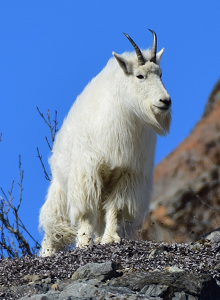By Kiana Young (NPS, Trent University), Tania Lewis (NPS), Kevin White (ADF&G), and Aaron Shafer (Trent University)
Are there populations of mountain goats within Glacier Bay National Park and Klondike Gold Rush National Historic Park that are vulnerable due to small numbers and isolation?
Dates
Fieldwork will be conducted March–September 2019 and 2020
Did You Know?

NPS
- Mountain goats are alpine specialists, meaning that they spend the majority of their time on and are highly adapted to steep, rocky mountains.
- Landscape features such as wide valley floors, glacial-covered mountains, and fjords can act as barriers to gene flow in mountain goat populations.
- Mountain goats are especially vulnerable to changes in their habitat caused by climate change. They rely on the cool temperatures and accessible alpine habitat, both of which are prone to change in the future.
Introduction

NPS
Southeast Alaska is dominated by wide fjords, glacier-covered mountains, and wide valley floors, so mountain goats populations can be genetically isolated and especially vulnerable to disturbances because genetic variability is low. Populations with low genetic variability are less likely to be capable of adapting to changes in their environment quickly. Knowledge of the population size and genetic structure of mountain goats will help determine which populations may be at risk .
This project is a collaborative effort between state and federal agencies. The goal of this study is to identify vulnerable populations of mountain goats within the park so that the park can make informed management decisions when designing upcoming backcountry management plans and predict the impact that climate change will have on the populations. The following questions will be investigated in this study:
1. What is the genetic population structure, abundance, and effective population size of specific populations of mountain goats in Glacier Bay?
2. Which populations in the park are vulnerable due to low genetic diversity and/or small actual and effective population size?
3. If genetically isolated mountain goat populations exist, what is their risk in regards to changes due to climate change?
Methods
Each park (GLBA and KLGO) has several study sites where mountain goat genetic material will be non-invasively collected. We will conduct aerial surveys both to obtain a population estimate well as to determine where the mountain goats are located within each study sites. Once we know where the mountain goats are, we will conduct ground surveys to collect fecal samples in each study area. This is done by observing where mountain goats are feeding and resting and then retrieving samples soon after the goats leave the area. Pellet samples will be swabbed and placed in a solution as well as collected whole and placed in a sterile, sealable plastic bag. Along with the sample collection, we will also record the date, study site name, and a GPS location.
DNA from the fecal samples will be extracted and analyzed in a genetics lab following each field season. The results will help us determine the number of migrants both within the park sites and between the park site and the surrounding area, the effective population size, and the genetic structure within the population.
Using the genetic data, we will run a series of simulations to predict the trajectory of vulnerable mountain goat populations under varied disturbance scenarios. We will synthesize knowledge about geographic barriers, proposed development (including trails and infrastructure) and simulations of the effects of climate change induced habitat changes on genetic diversity of mountain goats to develop adaptive management recommendations for goat populations in KLGO and GLBA. After determining the genetic structure of mountain goat populations in GLBA and KLGO, we will develop a genetic database for the two areas and a report detailing mountain goat effective population size estimates, genetic baseline information, population demographics, and adaptive management recommendations.
DNA from the fecal samples will be extracted and analyzed in a genetics lab following each field season. The results will help us determine the number of migrants both within the park sites and between the park site and the surrounding area, the effective population size, and the genetic structure within the population.
Using the genetic data, we will run a series of simulations to predict the trajectory of vulnerable mountain goat populations under varied disturbance scenarios. We will synthesize knowledge about geographic barriers, proposed development (including trails and infrastructure) and simulations of the effects of climate change induced habitat changes on genetic diversity of mountain goats to develop adaptive management recommendations for goat populations in KLGO and GLBA. After determining the genetic structure of mountain goat populations in GLBA and KLGO, we will develop a genetic database for the two areas and a report detailing mountain goat effective population size estimates, genetic baseline information, population demographics, and adaptive management recommendations.
Study Sites

NPS

NPS
Want to Help?
If you are planning on hiking in the mountains of Glacier Bay or Klondike Gold Rush and are interested in helping out with this project, contact the principal investigators for directions and a sampling kit.
Kiana Young (March-August): 907-697-2565; Kiana_Young@nps.gov,
Tania Lewis (year-round): 907-697-2668; Tania_Lewis@nps.gov
Kiana Young (March-August): 907-697-2565; Kiana_Young@nps.gov,
Tania Lewis (year-round): 907-697-2668; Tania_Lewis@nps.gov
Tags
- glacier bay national park & preserve
- klondike gold rush national historical park
- mountain goats
- mountain goat research
- climate change
- habitat loss
- marine protected areas
- glba
- glacier bay research highlights
- science
- marine animals and birds
- glacier bay national park
- klondike gold rush national historical park
Last updated: February 13, 2019
